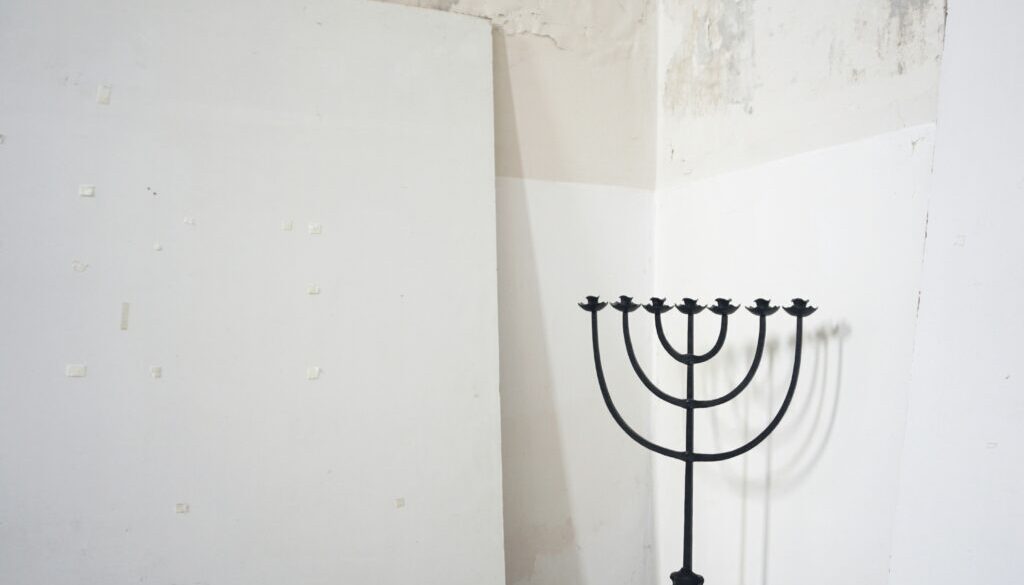Sermon Series on the Synagogue: Sermon Three of Three
The synagogue in the future: Build it, And They Will Come
If you want a thorough hot take (is that paradoxical?) on the Jewish future, I refer you to a recent article in The Atlantic called ‘The New American Judaism’, with the clickbaity subtitle: ‘Rabbis are in short supply, and congregations are struggling. But Jewish life is still thriving.’ Written by Shira Telushkin, the daughter of the prolific writer Rabbi Joseph Telushkin, the article does a good job sketching out some of the challenges, trends and opportunities of near future American Judaism.
Welcome to my third and final instalment of my sermon series on ‘The American Synagogue’. We’ve looked at the foundation of the synagogue in the ancient past and we have looked at synagogue trends in our current moment. Now we will take a look at what the future may bring and how we may meet the moment.
Telushkin’s ‘Atlantic’ article paints an unstable picture of congregational life. There is a national shortage of rabbis, so pulpits remain unfilled. For the past 15 years, applications to rabbinical schools have plummeted for a variety of reasons, including the significant burden of debt that needs to be taken on in order to complete five-year post-graduate training. There is also the shifting nature of the rabbinate itself, with rabbis becoming increasingly entrepreneurial, working in non-profits, hospitals, universities and day schools. At the same time, historically, seminaries have trained their rabbis for the gold standard of the pulpit, so there is a mismatch in training and expectations. The author is quick to note that this predicament is not only affecting the Jewish community. Secularization is on the rise and churches too suffer many of the same challenges and shortages.
Yet the story is not only grim. ‘New institutions of Jewish learning, social activism, and lay leadership have flourished, largely thanks to the growing engagement of younger Jews.’ That’s the good news. Telushkin cautions us by adding: ‘Very little of this renaissance, however, is affiliated with large, established synagogues… almost none of it is tied to the denominations… The centralized Judaism of the 20th century is giving way to a series of independent organizations, reflecting a broader trend across faith communities toward religious individualism. This new Judaism raises questions about what a rabbi should be in the 21st century…’
One criticism of the article I have is that Telushkin seems to make the very error that she has identified in Jewish institutional life: she focuses too much on ‘the rabbi’ in her analysis, and less on what is driving the current generations of Jews. In some ways, we are seeing paradigmatic disruption and generational fracturing; in other ways, this is a tale as old as time. This is why the historical perspective is so important: Jewish life has always been disrupted, been fractured and in response, innovated – the very institution of the Synagogue was once upon a time a revolutionary innovation; and before it, the Temple, and before that, the Tabernacle. We have always had divisions; sometimes healthy, sometimes not.
Even in the 20th century, the ‘centralized Judaism’ the author describes, came out of innovation. Many of you of a certain generation may remember the revolutionary empowerment of The Jewish Catalogue, the Chavurah movement and the counter cultural emergence of both Jewish spirituality and social action as key components of Jewish life. Now, those ideas are mainstream; as has the Independent Minyan movement of the Gen X’ers and Millennials (as I came of age). Now, Gen Z is charting its own course through our communal landscape. To put it in the words of our own Kohelet (Ecclesiastes): ‘v’ein kol chadash tachat ha’shemesh’ – ‘there is nothing new under the sun.’
What is the future of the contemporary synagogue? One prediction is post-denominationalism. ‘Long ago, Jews stopped thinking denominationally’, Rabbi Gary Glickstein, a Reform leader, notes in the article. Where Agudas Achim once was a quirky novelty, I have had several conversations with colleagues over the years asking me for advice on how to transition their own congregations to dual or multiple affiliation. In today’s Jewish world, we are ‘ideological grazers’, where we find inspiration in multiple ways to be, think and do Jewish.
A second change many congregations are grappling with are their financial, governance and dues structures. As economic pressures increase on younger generations, synagogues need to make absolutely clear that finances are not be a barrier to participation; and communicate this compassionately and effectively. Throughout my own Jewish journey, I know that I could not be the rabbi I am today without the philanthropic generosity of others.
Yet another change, one that has been afoot for a long time, is how we welcome and integrate interfaith families, spiritual seekers, the Jew-curious and converts into our communities. Those not Jewish, or in some cases, not yet Jewish, are an integral part of our communal life and their presence blesses and enriches us. As I said over the High Holidays, Judaism is not a zero sum game. The presence of newcomers in our midst strengthens us and allows us to prosper. We want you. You are welcome and beloved, as you are.
Even so, all these changes, important though they are, make one basic assumption: that the core institution itself remains constant. A synagogue is still conceived of in a certain mid-to-late twentieth century way – a fixed institution with physical walls. However, the future calls us to knock down the proverbial walls and reimagine the synagogue in more expansive and creative ways.
The synagogue, friends, is us. It is its people, our Torah and our God; the bonds of affection and mutual support between us, the wisdom tradition from which we seek guidance and inspiration, and the world of which we are inextricably part. The synagogue is this beautiful sanctuary and auxiliary spaces. The synagogue is also anywhere where Jews gather to find purpose, joy and meaning in their Judaism. The synagogue is in the home, the sanctuary and in the public space.
The ‘synagogue’ is just as much us making Havdalah at a local café and going bowling; it is just as much our team of volunteers cooking up a storm for the Free Lunch Program, going on a march or participating in Jewish cultural and literary life at the public library. The synagogue happens in people’s homes, in the streets, in our sukkahs, and in digital spaces. My rabbinate extends way beyond these walls; recently, I taught a digital course on conversion for the ‘UnYeshiva’, an emerging digital community of learners pushing the boundaries on what Judaism is and what it looks like. My rabbinate happens on Facebook (for good or ill, sometimes!) and on Zoom and sometimes even text message. My rabbinate happens in coffee shops and casual encounters. In my rabbinic mission, the ‘synagogue’, then is wherever I bring Torah to our aching world.
We need the ancient and the cutting edge, the established and the innovative, the anchor and the sail. We need the wisdom of our elders and the moral courage of our youth. The ‘synagogue of the future’ may or may not be in a fixed location, but what it must be is a mission-driven embrace of curiosity, openness and belonging in an increasingly fraught and lonely world. We all do ‘synagogue’ in so many small, tangible, important ways, whether it is participating in our Buddy System, welcoming a friend or being Jewishly-motivated to engage in civic action. ‘Synagogue’ may even be the quiet space of reflection we find; whether it is here in song and prayer, or in the silence of the forest, mountain or ocean.
The Jewish future is disrupted, complex, diverse, fragmented, fluid. Adaptive change is hard and exciting. It brings with it challenges and resistance, as well as invitation and opportunity. I think that the unspoken blessing of small communities like ours is our nimbleness, cohesion and creativity. We may lack the clout and resources of large communities but make up for it plenty in other ways. We can provide heartfelt community, genuine and important discourse and innovative programming with a short turnaround time. We are small but mighty.
Finally: the synagogue is you. We have journeyed for three weeks to examine who we are, where we came from and where we are going. I couldn’t do this incredible, holy, transformative work without any of you, and I think our future is bright.
Allow me to end with a rabbinic story, if I may, from Tractate Gittin 56a. When the Romans razed Jerusalem and burnt the Temple to the ground, all seemed lost. It was a moment of ultimate disruption in our people’s history. Yet the rabbinic sage, Yochanan ben Zakkai pleaded with Jewish militants to be smuggled out beyond Jerusalem’s walls in a coffin, as God’s House went up in flame. Emerging from his ruse before the military commander and Roman Emperor Vespasian, he was asked what his wish was. Yochanan ben Zakkai answered: ‘give me Yavneh and its sages.’ Yavneh was a town of no particular import. Yet, it is here where the first Batei Midrash, Houses of Learning, were built, and where, phoenix-like, Rabbinic Judaism rose from the ashes.
Between the Pittsburgh Massacre, the COVID pandemic and our post October 7th world, rising authoritarianism and climate change, the disruption of recent years invites us to turn to Yochanan ben Zakkai for courage and vision. I believe that we have what it takes for us as a community to journey into the future; to hold courageous conversations on our relationship to Israel, navigate political and ideological difference, learn from the rich experience and investments of our elders and the moral vision and energy of our youth, explore meaningful Jewish spirituality and be present in our local community with the fullness of our Judaism. And because I’ve gone sufficiently native, I won’t say, ‘give us Yavneh and its sages.’ Instead, I will close with ‘if you build it, they will come.’




